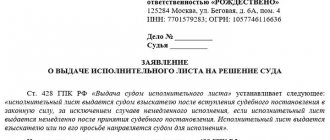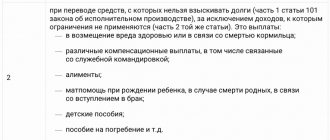Welcome to the family lawyer website. In this article, I decided to describe in detail the process of presenting a writ of execution to the bailiff service for execution. And since a personal visit to this institution can take up a lot of your personal time, and leave a very unpleasant aftertaste after communicating with employees of the FSSP of the Russian Federation, I will tell you how to send a writ of execution to bailiffs by mail, and thereby prolong the life of your already few nerve cells .
Types of executive documents
An executive document can be not only a writ of execution. The list of types of enforcement documents is quite extensive, and is presented in Article 12 of the Law “On Enforcement Proceedings”, according to which enforcement documents are:
- Writs of execution.
- Court orders.
- Agreements on payment of alimony certified by a notary.
- Judicial acts, acts of other bodies and officials in cases of administrative offenses.
- Resolutions of the bailiff.
- Notary's writ of execution, and other documents.
For the purposes of this article, we are only interested in the first two documents—the writ of execution and the court order . Further in the article I will use the term “executive document” , which includes both a writ of execution and a court order.
Holding Features
When making deductions from wages, you need to pay attention to the following nuances:
- withholding cannot apply to certain types of income, for example, state benefits or financial assistance from the federal budget, certain types of compensation payments, etc.;
- the fee for transferring money may be withheld from the employee in respect of whom this procedure is being carried out. This can be either a commission from a credit institution for processing a payment order or costs for transfer by mail. The percentage limitation established by law does not apply to these amounts;
- when a new requirement is received, the document is taken into account along with previously received ones, i.e., it is not postponed until the previous withholding requirements are fully satisfied;
- bailiffs can check how deductions are calculated, either on their own initiative or on the basis of a complaint from the claimant.
Writ of execution and court order
Both the writ of execution and the court order are executive documents and can be presented to the FSSP for execution.
This is the similarity between these documents. The main difference between a court order and a writ of execution is that a court order is very easy to cancel. The debtor only needs to meet the 10-day deadline and present his objections, and not even necessarily motivated ones. And in some cases, it is possible to cancel a court order even several years after it was issued.
There are, of course, other differences in these documents, for example, in the procedure for obtaining them, in the timing of issuance, etc. In this article, I see no point in describing in detail what the difference is between a writ of execution and a court order. I believe that by reading this text you already have in your hands either a court order, for example, to collect alimony, or a writ of execution.
Automation of accounting
To automatically process writs of execution in 1C, you must first configure the program, namely, check the box that requires deductions to be made on writs of execution. In this case, automatic calculation of deductions will be made in accordance with the entered requirements for each document.
Then you need to set up a list of payments that will participate in the formation of the base for deduction under executive documents. The list can be adjusted depending on what is indicated in the company’s local documents.
To enter information on a specific writ of execution in 1C, use the tab associated with deductions. In the document being created, you must indicate all the important conditions contained in the executive document. Based on the information entered, you can generate a registration card for the executive document. Information on all cards goes into a special journal for recording executive documents.
Direct deduction according to executive documents is carried out on the basis of a salary calculation operation. The accountant has the opportunity to disclose information and check the correctness of calculation of the amounts of deductions for a specific month of calculating wages to an individual.
Issuance of a writ of execution by the court
In most cases, the claimant can receive a writ of execution only after the court ruling has entered into legal force. Which is logical in principle, since a decision that has not entered into force can be appealed in appeal, cassation, etc., and it is not known what form the final judicial act will be in the final instance.
However, with a writ of execution for alimony there are exceptions to the rules. Since the court decision to collect alimony comes into force immediately, a writ of execution is also issued immediately after this decision is made. That is, in theory, immediately after the court announces the operative part of the decision, you can write an application for the issuance of a writ of execution, and they are obliged to issue it to you. In theory, everything is smooth. But in practice this does not happen often, and it is quite possible that you will have to come for a writ of execution only the next day.
In principle, the claimant can request that the court directly send a writ of execution for execution, so as not to go after it and ask the secretary. But this is again in theory. I still recommend getting a writ of execution in your hands.
But a court order is issued to the claimant if the debtor does not submit an objection to the court within the 10-day period established by law from the date of receipt of a copy of the order. Here you no longer need to write any statement; you already wrote it when you asked for a court order. By analogy with a writ of execution, you can also ask the court to independently send a court order for execution.
Independent presentation of a writ of execution to the bank
In order to independently receive money from the debtor’s account, the creditor must take the following actions:
- Determine which bank the debtor has an account with. In relation to a debtor organization, you can try to find out this through the tax service: it has information on all accounts of legal entities.
- Having received information about the current account, you need to contact the management of the bank branch. To do this, the claimant must write a statement to which the original sheet will be attached (the bank will not accept a copy). The application should indicate the details of the debtor's account, as well as the account of the creditor to which the funds will be transferred.
- Having received the sheet, the bank is obliged to carry out the transfer within 3 days, although situations are also possible when the operation will be postponed for another 7 days, since the bank may request information from the court.
- If there are sufficient funds in the debtor’s account, the execution procedure should be considered completed. If not, you will have to contact the bailiffs and wait for execution.
Deadlines for submitting writs of execution for execution
The deadline for presenting a writ of execution issued on the basis of a judicial act is three years from the date of entry into force of the judicial act. It is from the day the court decision comes into force, and not from the day the writ of execution is received. Because receiving it or not is your personal right. In my opinion, three years is more than enough to receive a writ of execution and send it to the bailiffs.
There is also a 3 year period for presenting a court order for execution. But in this case, the three-year period will be calculated from the date of issue of the court order. The date of issue is indicated in the order itself.
However, there are exceptions to the deadlines for presentation. Thus, enforcement documents containing demands for the collection of periodic payments can be presented for execution during the entire period for which payments are awarded, as well as within three years after the end of this period. Accordingly, a writ of execution or a court order, for example, to collect alimony for a minor child, can be presented until the child reaches the age of 21.
There are other deadlines, or cases when, for example, the flow of the period is suspended and interrupted. Or cases where the bailiff completed enforcement proceedings due to the impossibility of collection and returned the enforcement document to the collector. In this article I will not consider such situations. I believe that at the moment you are going to file the writ of execution for the first time, which means that you will not have any surprises with the timing.
Final stage
If the applicant did everything correctly, sent the writ of execution to the bailiff service on time, and the bailiff initiated enforcement proceedings, then appropriate measures are taken to enforce the court decision.
For example, a bailiff decides to seize the debtor’s property if a court decision requires the collection of a certain amount of money. In particular, the debtor's bank accounts, real estate and movable property are seized. If the debtor has enough funds to satisfy the applicant's demands, the bailiff will confiscate them. If the debtor works, then part of his salary is confiscated every month. If he does not work and does not have money, then his other property is confiscated and must be sold at auction.
Very often, a court decision requires the debtor to carry out certain actions in favor of the applicant. In this case, the bailiff ensures that these actions are carried out forcibly, and if necessary, various sanctions can be applied to the debtor.
Author of the article
Dmitry Leonov
Work experience 15 years, specialization - housing, family, inheritance, land, criminal cases.
Author's rating
721
Articles written
712
about the author
Useful information on bailiffs
- How long after the trial do the bailiffs arrive?
- Can bailiffs withdraw money from a Sberbank bank card?
- How much can bailiffs deduct from salaries?
- Can bailiffs withdraw money from a salary card?
- Seizure of a car by bailiffs, is it possible to drive?
- If the bailiffs are inactive, a complaint against the bailiffs
- Who can you complain to about bailiffs?
- Submission of a writ of execution to the bailiff service
- Can bailiffs describe parents' property for children's debts?
- Actions of bailiffs on a writ of execution
- Sample complaint to the prosecutor's office against the bailiff
- Can bailiffs seize a credit account?
- Inquiry about the progress of enforcement proceedings
- The paid traffic fine was handed over to the bailiffs
- Do bailiffs have the right to withdraw money from pensions?
- Do bailiffs have the right to open an apartment without the owner?
- How to negotiate with bailiffs to pay the debt in installments
- The bailiffs do not comply with the court decision, what should I do?
- Can bailiffs seize a salary card?
- Terms of enforcement proceedings with bailiffs
- Does a bailiff have the right to seize a pension?
- Can bailiffs seize child benefits?
- Can bailiffs seize the only home?
- Can bailiffs seize a car?
- Can bailiffs seize a Sberbank card?
- Car arrest
- Can bailiffs describe property without a court order?
- How do bailiffs find out the debtor’s place of work?
- What property can bailiffs describe?
- How to remove a lien from an apartment
- Seizure of property not belonging to the debtor
- If the debtor does not pay according to the writ of execution
- Information about arrests of bailiffs
- How to revoke a writ of execution from bailiffs
- How not to pay bailiffs according to a court decision
- How to find out fines from bailiffs
- Can a bailiff withdraw money from an account without notice?
- How to submit a writ of execution to bailiffs
- What accounts cannot be seized by bailiffs?
- Search for debtors by bailiffs
- How to remove a car from being seized by bailiffs
- What to do if you receive a letter from the bailiffs
- Certificate for bailiffs from the place of work about the salary card
- How to view a writ of execution from bailiffs
- Credit card seizure
- Answer to the bailiffs that the person is not working
- When bailiffs have the right to describe property
Documents for filing a writ of execution
To send a writ of execution or court order by mail, you must collect the following documents:
- Application for initiation of enforcement proceedings.
- Executive document (original).
- A copy of the writ of execution.
- A copy of the claimant's passport.
- A copy of the tax collector's tax identification number.
- Bank account details of the claimant.
- A copy of the birth certificate of the child, children (when submitting a writ of execution for the collection of alimony).
Filling out an application to initiate enforcement proceedings
I have already prepared the correct sample application to the bailiffs for you. It's possible. An application using this sample was repeatedly drawn up and sent to bailiffs in different regions of the Russian Federation.
It is very important to fill out the application to initiate enforcement proceedings carefully and avoid mistakes. In the sample that you downloaded, you must enter your data in the lines highlighted in red It is what is highlighted in red that must be filled out. I wrote below how to find out the name of the bailiff department.
Everything else under the line “ At the same time I provide the following available information about the debtor ” can be filled out if you know this information. It is better to fill out everything that is known - it is in the interests of the claimant. Don't forget to put the date and signature at the end of the application.
Ways to protect the debtor
A citizen officially becomes a debtor in enforcement proceedings from the moment the bailiff issues a corresponding resolution. The case can be initiated at the request of the claimant or based on documents sent directly from the court.
You can find out that collection proceedings have been initiated against you:
- from the FSSP resolution;
- through an Internet service on public services, which displays data on all open industries;
- through the Data Bank on the bailiffs portal.
If the bailiff violates the rules of notification of the initiation of a case, you can find out about this fact after the start of the lien, after the introduction of arrests and bans. In order to take protective measures in a timely manner, we recommend that you independently check the information about the existence of initiated proceedings.
Judicial protection
The debtor can exercise the right to judicial protection when considering a claim or filing applications for the issuance of orders. In enforcement proceedings, judicial protection is available in the following cases:
- through higher courts, you can continue to appeal against the penalty, even if the bailiffs have already initiated proceedings;
- complaints can be filed with the courts against the inaction, decisions and actions of representatives of the FSSP;
- Through the court you can try to defer or install payments on debts;
- only the court can consider an application to reduce the amount of the enforcement fee.
If bailiffs systematically violate the debtor’s legitimate interests, you can repeatedly go to court. Each complaint or appeal will be considered on its merits. In some cases, going to court will automatically lead to the suspension of enforcement actions.
If the debtor is able to cancel the judicial act of collection, he has the right to demand the termination of enforcement proceedings. The right to file an application to court to reverse the case also arises. The procedure for reversing the case consists of returning to the former debtor the funds and property withheld at the request of the claimant.
Defense at the stage of initiating enforcement proceedings
From the moment the proceedings are initiated, the bailiffs can begin enforcement actions. For its part, the debtor can take the initiative and prevent such actions.
You can demand the cancellation of the decision to initiate on the following grounds:
- if the deadline for submitting documents for execution is violated (for example, a court order can be sent for execution to the FSSP within 3 years);
- if an improper enforcement document is sent to the bailiffs (for example, a loan agreement is not such a document, since the loan debt must first be confirmed by the court);
- if an inappropriate person applied to the FSSP (for example, if a writ of execution was filed by a representative of the claimant without a power of attorney);
- if at the time of contacting the FSSP the judicial act has already been canceled (for example, this very often happens when a court order is canceled due to the defendant’s objections).
It is better to file a complaint against the decision to initiate a case in court. Law No. 229-FZ allows you to send a complaint to a higher bailiff, but in this case it is difficult to count on an objective consideration. If the court cancels the decision, the bailiff will not be able to begin enforcement actions.
How to protect yourself from arrests, bans and restrictions
Arrests, prohibitions and restrictions are considered interim measures in executive law. They should encourage the debtor to pay the creditor as soon as possible. Seizures and restrictions also ensure that the debtor’s income will not be used for purposes unrelated to debt repayment.
Arrests, restrictions and bans are introduced by resolution of the FSSP. The debtor has the right:
- appeal the decision and completely cancel the seizure or ban (for example, if the bailiff illegally seized someone else’s property that was temporarily in the debtor’s possession);
- partially lift restrictions on the disposal of funds (for example, this is possible for social payments and child benefits, for which deductions are prohibited);
- ask for the removal of the seizure from certain types of property if the debtor offers other assets of equal value in return (for example, you can try to remove the seizure from a car by offering the bailiff other things or items of the same value).
Arrests and bans can be completely lifted if the bailiff violated the rules for introducing them.
For example, property can be seized only for debts of 3,000 rubles and above. Your driver's license can be revoked if you owe more than 30,000 rubles (for alimony - from 10,000 rubles). If the bailiff violated these provisions of the law, restrictions and arrests can be lifted through the court.
Let us note that it is impossible to demand the removal of seizures from property that is prohibited from being sold for debts. Any assets belonging to the debtor can be seized. In this case, the arrest or ban on registration actions will remain until the debt is fully repaid, or until the termination (end) of the proceedings.
Protection from enforcement actions
The list of enforcement actions that bailiffs can take is specified in Law No. 229-FZ. This may be a search for the property of the defaulter and himself, a visit to the place of residence, an inventory of assets and their seizure for safekeeping. For each executive action, procedural acts are drawn up, from the FSSP resolution to the inventory of assets.
Let us highlight several effective options for protection from enforcement actions by bailiffs:
- you can file complaints about any violations of the law by FSSP specialists;
- the debtor has the right to participate in each enforcement action, indicate his objections and explanations in procedural documents;
- Bailiffs must be required to comply with the time of day when carrying out enforcement actions (note that in exceptional cases actions can be carried out at any time).
Protection of the debtor in enforcement proceedings is carried out within the framework of Federal Law No. 229-FZ.
Measures to protect the debtor include filing complaints, participating in enforcement actions, obtaining deferments and installment plans for the payment of debt. Special protection measures are provided in case of initiation of administrative and criminal cases against the debtor.
The debtor is notified in advance of the execution of enforcement actions (except in urgent and exceptional cases). But even here, the bailiffs can only indicate the action itself, but not the exact date (time) of its commission. Therefore, a visit by FSSP employees to the debtor’s home may come as a complete surprise.
To protect your interests, we recommend preparing in advance for all possible actions on the part of the bailiffs. Our lawyers are ready to provide assistance on these issues.
Legal remedies for debits from accounts and cards
Writing off money from bank accounts and cards is one of the main enforcement actions that bailiffs will definitely begin. To withhold from wages and other periodic income, the bailiff is required to indicate the maximum amount - 50% or 70%. The remaining funds after write-off will remain with the debtor. But there are no withholding restrictions regarding your account or card balance.
With respect to liens, the debtor may take the following defenses:
- appeal against exceeding the maximum withholding amount;
- demand the removal of blocking from payments that are prohibited from being withheld;
- submit applications for the return of illegally debited funds.
We recommend immediately withdrawing the money remaining after deduction from the card. If there is a balance on the card when the next salary arrives, the bailiffs can write off its entire amount. This is also one of the protection options that not all debtors know about.
Protecting the interests of the debtor during the sale of property
If it comes to the sale of property, the debtor will have several more options for protection. Unfortunately, only certain types of assets listed in Art. 446 Code of Civil Procedure of the Russian Federation. The following measures can be used to protect interests:
- appeal the results of asset valuation, demand the involvement of a professional appraiser;
- seek exclusion of property from the inventory if the bailiff violated the law during its preparation;
- file complaints about actions and decisions when selling assets through auctions.
The debtor can submit a petition to the FSSP to independently sell the property. The bailiff may agree to this type of sale if it does not violate the interests of the creditor, and all proceeds will be used to pay off the debt. Our lawyers will help you prepare documents for independent implementation.
Complaints about bailiffs
Complaints are one of the most accessible and effective options for protecting a debtor in enforcement proceedings. You can complain to the court or to a higher FSSP official. The debtor may file a complaint:
- on the actions of a representative of the FSSP (for example, on illegal seizure of property, on unlawful forceful actions);
- on decisions and other procedural documents (for example, you can appeal any decision of the FSSP if it violates the interests of the debtor);
- on the inaction of an FSSP employee (for example, if the bailiff is in no hurry to complete the proceedings after full repayment of the debt).
The deadline for filing a complaint is 10 days from the moment when the interests of the debtor were violated. For example, this period will begin to run from the moment a copy of the resolution or other document is received. To achieve a positive result when appealing, we recommend that you seek help from our specialists.
Sample complaint against bailiffs (23.0 KB)
Where to submit the writ of execution?
In order to send a writ of execution, you must first find out which bailiffs and to which department in your case it should be submitted, as well as the address of this institution. First, let’s see what the law called the Federal Law “On Enforcement Proceedings” will tell us about this.
And this is what he tells us:
- Part 3 Art. 30 of this Federal Law states that the executive document and application are submitted by the claimant at the place of execution of enforcement actions, determined in accordance with Article 33 of the same Federal Law. And in accordance with part 4 of the same article, if the claimant does not know in which department of the bailiffs the enforcement proceedings should be initiated, then he has the right to send the executive document and application to the territorial body of the Federal Bailiff Service (the chief bailiff of the subject of the Russian Federation), determined in in accordance with the same article 33.
- From Article 33 we learn that if the debtor is a citizen, then enforcement actions are carried out at his place of residence, place of stay or location of his property. And in the absence of information about the location of the debtor and his property, enforcement actions are carried out at the last known place of residence or place of stay of the debtor or at the place of residence of the claimant until the location of the debtor and his property is established.
Simply put, if you know exactly where the debtor lives, send it to his place of residence. If the place of residence is unknown, but you know where, for example, the debtor’s apartment is located, then you can file at the location of the apartment. Well, if there is no information about the debtor at all, you can file at your place of residence, or at the last known place of residence of the debtor. As a last resort, you can send it to the chief bailiff of the subject of the Russian Federation in which you live, for example, the chief bailiff of the Krasnodar Territory. And he will then decide which department of the FSSP to send your documents to.
Of course, it is in the interests of the collector to find out the exact location of the debtor, his place of work, and provide this information to the bailiff. Thus, the creditor will significantly speed up the process of replenishing the balance of his bank card at the expense of the debtor’s funds. The bailiff will, of course, find the debtor himself, but how quickly he will do this, given his workload and lack of motivation, is of course an interesting question.
A very common situation: the debtor is registered (registered) in one place, but lives in another place, and you reliably know his place of residence and address. So, in this case, I recommend sending the writ of execution exactly to the actual residence address of the debtor. If you know the debtor's phone number, be sure to indicate it in the application.
So, we figured out where to send the executive document. Now we need to find the department we need and its postal address. You can find it on the Internet using a search engine, or in any directory of organizations, or on the FSSP website. I suggest using the latter method. On the official website fssp.gov.ru there is a section “Register of bailiff departments”. Perhaps over time the appearance or link to the registry page will change, but the service itself will still remain, so you can find it.
Let's assume the debtor's address: Krasnoyarsk, Zheleznodorozhny district, st. Lunacharskogo, 9, apt. 395 (all matches are random).
Go >>here to the service page<< and see the fields for data entry:
We enter “Krasnoyarsk Zheleznodorozhny district” there and select the region “Krasnoyarsk Territory”. Next, click “Find”.
The search gave us information that this area is served by “OSP in the Zheleznodorozhny district of Krasnoyarsk”, and the address of the department is “660075, Krasnoyarsk, st. Maerchaka, 38.”
Actually, that's all we need. Now knowing the OSP address, you can send documents by mail.
How to find out which department of bailiffs to submit the writ of execution to
The FSSP is built on a territorial principle. Therefore, there are usually no difficulties in determining the bailiff department. The sheet should be submitted to the authority located at the place of residence or permanent location of the debtor or the main part of his property (usually real estate).
If the claimant does not know this information, then the appeal is submitted according to the address data recorded in the court decision. The work of the bailiffs is not only to recover, but also to search for property, as well as to establish the location of the hiding defendant.
Hotline for citizen consultations: 8-804-333-70-30
How to send a writ of execution by mail?
I recommend sending the executive document with all attachments by a valuable 1st class letter with a list of attachments. It is better to buy a polyethylene mailing envelope, it is still stronger. Or a paper envelope, but first put the entire package of documents in a multifor. Since you are not sending simple pieces of paper, but an executive document, and it is in your interests that everything arrives safe and sound.
The first step is to fill out the investment inventory in two copies. One copy will be sent in a letter, the other will remain with you. The inventory can be filled out online on the official website of the Russian Post, but for this you need to register a personal account. There are other services on the Internet. And there is an even simpler way, since I have prepared a blank inventory form for you, which you need to fill out.
This is what the completed inventory form looks like. For sample.
Be sure to sign both forms and indicate the value of the investment. The value of the investment can be 1 ruble or 1000 rubles. It's as you wish. Just keep in mind that the final cost of Russian Post services for the delivery of your documents will be calculated based on the evaluation of the letter.
After the inventory has been filled out, fill out the envelope. There are no difficulties here. We have already found the address. Next, you need to place all the documents in the envelope, but do not need to seal it. We take everything to the post office. There, an employee will check the contents with the inventory, put signatures and seals. One inventory form will be placed in an envelope and sealed. The second inventory form will be given to you. You pay for the postage, receive a receipt and track the shipment on the post office website. You can check with the postal employee about the approximate delivery time of the letter.
By the way, I recommend, just in case, before sending the original document of execution, make a copy of it for yourself.
How to find out whether enforcement proceedings have been initiated?
Usually a 1st class letter goes very quickly, especially within one region of the Russian Federation. As soon as the letter is received by the bailiff department, the countdown can begin.
The bailiff, within three days from the date of receipt of the enforcement document, is obliged to issue a resolution to initiate enforcement proceedings or to refuse to initiate enforcement proceedings. And if your writ of execution is subject to immediate execution, for example on the collection of alimony, the bailiff has one day to make a decision. If you did everything correctly, the result will be the initiation of enforcement proceedings.
In theory, and even by law, the bailiff is obliged to send a copy of the decision to initiate or refuse to initiate enforcement proceedings to both the debtor and the collector, and even to the court that issued the enforcement document. And he must do this the very next day after the decision is made. But this is all in theory. But in practice this does not always happen.
If you need a copy of the resolution to initiate enforcement proceedings, you can send a letter to the bailiff department with a request to send you a copy. And to find out whether enforcement proceedings have been initiated, we go back to the FSSP website. There is a useful service there, called the “Bank of Enforcement Proceedings.”
Select the region, enter the name of the debtor, and click “Find”.
If enforcement proceedings are initiated, you will see this result:
The date of initiation of enforcement proceedings and its number, as well as the number of the writ of execution, or details of the court order are indicated here. Be sure to check the debtor's date of birth, because... There are often coincidental names.
Next stage
If the court decision was not voluntarily executed by the defendant, then the plaintiff may present the writ of execution to the bailiffs. To do this, you must draw up a corresponding application.
The application must provide the following information:
- applicant’s details (full name, city and address of residence, passport details, etc.);
- details of the debtor or defendant (full name, city and address of residence, if possible, passport details, etc.);
- data on judicial proceedings;
- a brief description of the court decision;
- when this decision came into force and when the writ of execution was issued;
- what actions must be carried out by the bailiff;
- other information that will help find the debtor or his property.
The application must be signed by the applicant or his legal representative. If the application is submitted by a representative, then a power of attorney must be attached to it. The original writ of execution must also be attached to the application. Of course, you also need to make a copy of it, which you need to keep for yourself.
Which department should the application be sent to? The bailiff department must be chosen correctly, otherwise the writ of execution will be returned to the applicant. In particular, first of all it is necessary to find out the city of residence of the defendant and only after that send an application to the bailiff department of that city. This is the department you need to contact.
The application can be sent by mail.










